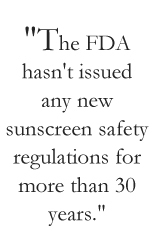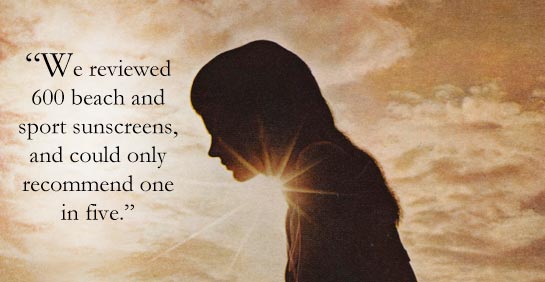A new report claims that only 1 out of every 5 sunscreens is safe and effective.
Sunscreen will keep you wrinkle free and cancer free, right? Not quite, says a startling new report from the Environmental Working Group, a non-profit organization that conducts research on public health and the environment. “Most peopl e don’t realize that the FDA hasn’t issued any new sunscreen safety regulations for more than 30 years,” says Nneka Leiba, a research analyst who worked on EWG’s Sunscreen 2011 Safety Guide. “So manufactures can sell products that don’t perform well and can make a lot of unfounded claims.”
e don’t realize that the FDA hasn’t issued any new sunscreen safety regulations for more than 30 years,” says Nneka Leiba, a research analyst who worked on EWG’s Sunscreen 2011 Safety Guide. “So manufactures can sell products that don’t perform well and can make a lot of unfounded claims.”
Here, Nneka explains exactly what makes a sunscreen “safe.” . . . Does yours make the cut?
- FOF: Why doesn’t the FDA ensure that these products are safe?!
- Nneka: The FDA first released it’s recommended regulation draft for sunscreen in 1978, but, believe it or not, it’s never been finalized. There are certain requirements–for example, sunscreens must list all their ingredients. However they don’t have to prove that those ingredients actually work or are safe for everyone.
- How did your study work?
- We have a database called Skin Deep where we analyze all sorts of consumer beauty products by comparing their ingredients to the most recent scientific literature on health effects including cancer and reproductive toxicity. For our Sunscreen Report, we take it a step further and also look at the UVA and UVB protection the products provide.

- When you look at the SPF number, that only applies to UVB rays. We now know that UVA rays are also very dangerous, but sunscreen manufacturers aren’t required to print their UVA protection factor on the bottle. Many claim to be “broad spectrum”, meaning they protect against both UVA and UVB, but no one is actually checking these claims. In Europe there are actual guidelines for UVA protection that many products sold in America simply don’t meet. An example on our website is Hawaiian Tropic Baby Stick Sunscreen SPF 50. The UVA protection factor is actually less than 10–not good enough to be sold in Europe.
- More than 1700 SPF products–that includes lip balms, makeups, moisturizers. Of the 600 beach and sport sunscreens, we could only recommend 1 in 5.
- A recommended sunscreen must provide both UVA and UVB protection and can’t contain hazardous chemicals that penetrate the skin.
- There are two that we really call out. The first is oxybenzone, which is in about 50 percent of sunscreen products. It’s been shown to trigger allergic reactions, disrupt hormones and penetrate the skin in relatively large amounts. Scientists have gone as far as warning parents to avoid using it on children.
- The other ingredient is retinyl palmitate, a form of vitamin A found in about 1 in 3 products. It’s an antioxidant associated with slowing the appearance of skin aging, but data from and FDA study suggested that if worn in the sun, it can actually speed the development of skin tumors and lesions. So in night creams it’s fine, but we’re very concerned about seeing it in sunscreen.
- Any spray sunscreens. These ingredients are not meant to be inhaled into the lungs. We also ask that people avoid SPF higher than 50+ because it’s misleading. People get a false sense of security and fail to reapply. No matter how high the SPF, these blocks are simply not effective unless you reapply every two hours.
- We don’t advocate specific brands–you’ll have to look at the list for the ratings. But the sunscreens with the highest ratings are are mineral sunblocks. They provide broad spectrum protection (UVA and UVB) and they don’t readily penetrate unbroken skin. Key mineral-block ingredients are titanium dioxide and zinc oxide.
- Here’s a list of 5 sunscreens that received the best possible score from EWG (a 1 out of 5; 5 being the worst.) A complete list of sunscreens and their ratings can be found here.
- Aveeno Baby Natural Protection Mineral Sunblock, SPF 50
- California Baby No Fragrance Sunscreen, SPF 30
- Elemental Herbs Sunscreen Sport, SPF 20
- Kiss My Face 100% Natural Pink Sunstick
- Marie Veronique Organics Moisturizing Face Screen, Light Tint, SPF 30
What was your sunscreen’s rating? Tell us in the comments below.
| Author | |
 |
Research Analyst Nneka Lieba, M.Phil., MPH is a Research Analyst with the Environmental Working Group. She received her Masters in Public Health from The Johns Hopkins University. |


0 Responses to “Is Your Sunscreen Safe?”
cathiecoats says:
No clue why Skin 2 Skin is not on the evaluation list. I would not use anything but this every day. It uses Zinc Oxide, a powerful anti-oxidant, and Titanium Dioxide, multi-disbursing reflectors of both UVA and UVB rays. The FDA only recognizes these two ingredients as UVA and UVB sunscreens. Check it out at http://www.skin2skincare.com.
Catalina says:
I use Shiseido Sun Protection lotion spf which has mostly a high percentage of zinc oxide but is sadly not on the list. I do love this sunscreen!
financialwoman says:
As someone who is chemical sensitive anyway, this is great info. thanks!
camille gaines
financialwoman.com
FabulousMimi says:
the only ones I have not had an allergic reaction to have had clear zinc oxide as the main ingredient. I recently found a new one that I would like to try by “Smart Girls Who Surf” which claims to have all natural, no chemicals and safe for the environment.The label and website appears to list only natural minerals. I cannot wait to try it.
jolin says:
I think I may be allergic to sunscreen (itchy skin where applied) Anyone have any thoughts to a hypo-allergenic sunscreen?
Loraine says:
Mine got a 7 its has good coverage but has that oxybenzone in it that makes me worry but I really love it because it layers invisibly under makeup and is not to expensive ,I only put in on on days I’m going out of the house which is about 4 times a week and I do not go to the beach or sit in the sun .
babysteps74 says:
both of the ones I recently purchased are not faring so well-Neutro gena and Hawaiin Tropic Sheer touch! Thanks for the info, especially about the false sense of security with the higher SPFs-
Loie Docter says:
I have recently discovered Rodan and Fields anti-aging products. I use their mosturizer (SPF 30) daily. R & F are extremely reputable dermatologists (developed Pro-Activ) and have now added a new sunscreen product to their offering. They have a bracelet that indicates UV ray exposure by turning color, from white to purple, a reminder to apply or reapply. I highly recommend this product line.
linaperl says:
Mine got a “3”….not bad, but I’ll definitely be ordering one of the “1”-rated products!